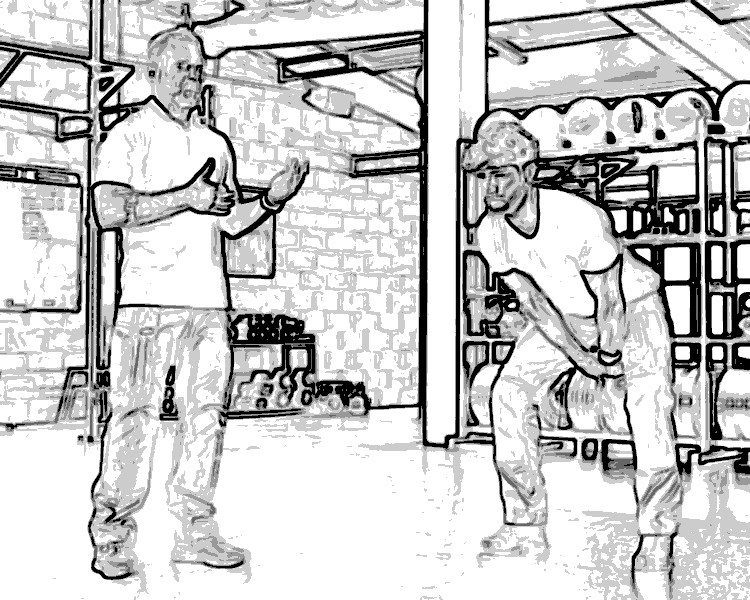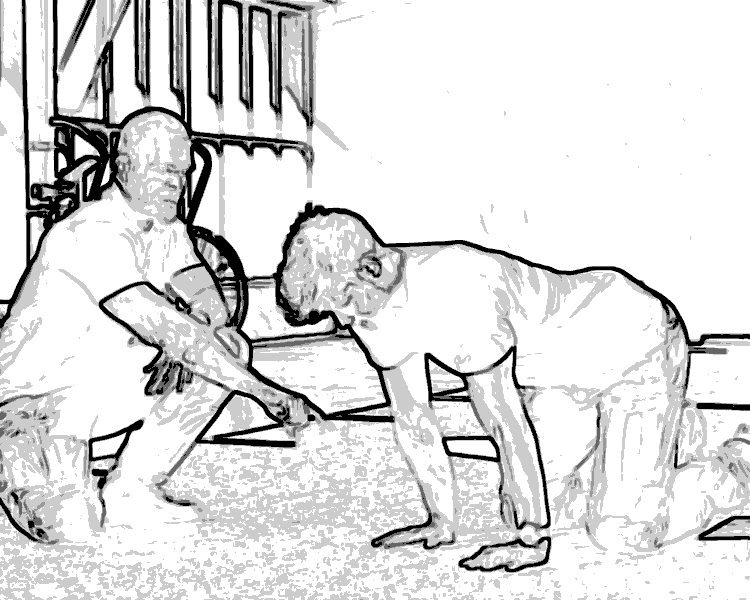You must be in top physical condition for the Special Forces selection process because it will subject you to some of the most extreme tests of physical strength and endurance imaginable. In this blog post, SF selection expert Michael Strauch helps you prepare by sharing his favorite SF training exercises—from those that get your body properly warmed up to those that build muscle where you’ll need it most, and from exercises that optimise your cardiovascular performance to exercises that safely cool you down at the end of the workout.
In this blog post:
Introduction
You cannot show up for Special Forces selection without being in top physical shape. This is not an option; you must right now be totally committed to engaging in rigorous training exercises because, during the SF selection process, you’ll be subjected to the most extreme tests of physical strength and endurance imaginable. And if you haven’t faithfully trained, you’re almost certain to wash out.
Therefore, I am going to share with you now a variety of basic techniques that will put you on the path to being physically prepared. These are techniques I strongly encourage you to include in your training program.
We begin with a warm-up program that includes all of the exercises I believe essential to make your body ready for an aggressive SF training workout.
These exercises are my favorites, chosen based on experience. If you think other warm-up exercises would increase the benefits you stand to gain, then by all means make use of them. Remember that proper planning and preparation are always your own responsibility.
Activation exercises
Activation exercises are designed to “wake up” your muscles so that they can function correctly.
- Start off with a lateral banded walk. This will activate your lateral gluteus muscles.

- Next up is a banded hamstring stretch. A dynamic stretch, it works the hamstrings as well as activates your core muscles.

- Lastly is the cook bridge. It relaxes your tight hip flexors and at the same time activates your large glute muscles.

Dynamic warmup
Try to keep your dynamic warmup as short as possible, but by the same token don’t rush through because you need the full benefits it offers (which revolve mainly around the maximisation of injury prevention).
- Knee grab. Make sure you pull the knee in toward your chest, not your chest toward the knee.

- The froggie. When you do the froggie, pull your foot as high as possible (try imagining yourself stepping over a fence).

- Toe grab. You don’t necessarily have to touch your toes; the important thing is that you reach for them so that you feel the stretch in your hamstrings.

- Hands and heels (also known as the elephant walk). Try to keep your heels flat on the ground and perform walking by raising your hip.

- Contralateral crawl. It is essential to move the hand and the foot at the same time and at the same speed. Also keep your back straight.

- Inquartata. Remember that you move in squares. Don’t cross too far over your feet.

- Lunge twist. Always twist toward the side of the planted foot. In advanced versions, try to keep your rear knee off the ground.

Basic-movement categories
After completing the dynamic warmup exercises listed above, you’ll be ready to begin those in the basic-movement categories described below.
Squats

Squats are a quad-dominant movement. I am not a fan of the regular bar-squat, but I am of the goblet squat. Goblet squats are easy to perform and they work your full range of motion.
My favorite quad-dominant movement is the lunge. I like most of all the star lunge, where you move in all directions by using both legs. You can also alternate your step length if you want to do a more advanced version of this exercise. The star lunge is a drill that helps injury proof your joints and ligaments. To make it harder (and better), add an uneven weight.
Hinges
The most familiar of hinge movements is the deadlift. I don’t like to go really heavy on the deadlift, but I would certainly use it in greasing-the-groove situations.
Read more about greasing-the-groove here.
Kettlebell swings

When you perform this swing, be sure you accelerate the arc of the kettlebell by using explosive hip movements rather than pulling the kettlebell with your shoulders or by doing squats.
Horizontal push

When I say “horizontal push,” I’m not talking about doing bench presses. I’m talking about one-arm pushups. The easy version (the one you should start with) entails putting yourself into pushup position, extending one leg at 90 degrees, and supporting yourself with one hand while the other hand rests on that leg. To increase the difficulty as you progress, shift the leg backwards to a 45-degree angle. The hardest version is when both legs are straight back.
Vertical push
This exercise has an up version and a down version. For down, I recommend ring dips (I know, ring dips are bilateral, but you need a lot of stabilization work to keep yourself in a good position). When you perform ring dips, it’s important to use the full range of motion and avoid pinching up your shoulders.
For the up version of the vertical push, you can do a shoulder press. I recommend one-arm kettlebell presses.
Horizontal pull

In my opinion, the best horizontal-pull exercise is the sled pull with rope. It’s good for grip strength, latissimus muscle activation, and overall strengthening and conditioning.
The sled pull is a unilateral movement and good for stabilization. If you don’t have access to a sled machine, try to do some other unilateral movements (but not exclusively on machines).
Vertical pull

The quintessential vertical-pull movement is the pull-up. You’ll see that it’s part of most of the SF selections. Another important vertical-pull exercise you must practice is rope climbing. It offers many benefits, including efficiency and strength.
Core exercises

Core exercises work on a spectrum—at one end is stability, at the other is movement. An example of an exercise that leans toward stability is the get-up. One that leans toward movement is the sandbag clean-to-shoulder. Some other ground bodyweight movements are the crab walk, bear walk, and scorpion. Off-the-ground movements include any slamball or wall-ball exercises.
Get-up exercises teach you the most effective and efficient ways of rising. To perform these, position one leg straight back and the other leg outward at a 45-degree angle; position your arm at a 45-degree angle and keep your eyes on the weight.
As for movement exercises, the asymmetrical sandbag clean-to-shoulder is a great one (I prefer asymmetrical movements because they are natural). To perform this exercise, use an uneven grip and pull the sandbag to your shoulder in one fluid motion.
Then there are shuttle sprints. They train acceleration, deceleration, and change of direction. They are useful on the battlefield when switching covers. But you also must work your body from other directions, using exercises like track sprints, hill sprints, and sled pushes.
Heavy carrying
No rocket science here. All you do is pick up heavy stuff and walk around with it. Lots of options when it comes to heavy stuff: you’ve got dumbbells, sandbags, and more. By the way, dumbbells would be considered a regular option, while sandbags would be considered irregular.
Endurance and conditioning
Endurance and conditioning divide into two subcategories. First, cycling conditioning. Second, conditioning with full-body movements.
Cycling conditioning
This is where you do the same movement over and over. Examples are biking, rucking, swimming, and running.
With cycling conditioning, you’ll have three targets. They are:
- Aerobic efficiency. To achieve aerobic efficiency, begin unloaded (i.e., carrying no weight). Jog or walk for 30 minutes, or at least as close to that as you can come. Try to keep your heart rate in the range of 60- to 70-percent of HRMAX (this is your target heart-rate). After the 30-minute jog, continue rucking for 90 minutes but now add some load (start with 8 kg) and strive to maintain your heart rate within the target range. Gradually increase the weight (top out at 24 kg). The ultimate goal is to complete 10 kilometers within 90 minutes without going beyond your target heart-rate.
- Anaerobic threshold. Here, your target heart-rate would be around 80 to 90 percent. Start with a five-minute jog and increase it by one minute every week until you reach 20 minutes duration. When you reach that time goal, continue jogging for an additional 20 to 30 minutes at 70 to 80 percent of your normal heart-rate.
- Maximum power output. This is basically sprints and agility training. For sprints, you would start off with a 40-metre dash. Run it as fast as you can, then walk back and repeat. The goal is 10 repetitions, but your sprint time shouldn’t differ by more than 0.2 seconds from one rep to the next. When you can do 10 reps, increase the distance to 60 metres. In contrast, when doing shuttle runs, the distance should be around 10 to 20 metres. Start in the middle, run to one side, run to the opposite side, and then run back to the starting point.
Conditioning with full-body movements
Conditioning with full-body movements offers you a large selection of exercises from which to choose. It also permits programming of different movement patterns.
You should always use the movement patterns most helpful in advancing you toward what you are trying to achieve. In this way, you train endurance as well as movements.
High Intensity Interval Training (HIIT)
HIIT involves a full-bore burst of cardiovascular exercise followed by rest that lasts at least as long as the exercise you just finished. When you do HIIT, hit it as hard as possible for as long as possible, but most importantly without any compromise of the technique you use to perform each exercise.
There are two terms with which you need to be familiar regarding HIIT timeframes.
- AMRAP. This stands for “as many repetitions or rounds as possible.”
- “Go for time.” This means “do a set amount of work as fast as possible within the allotted time.” Unless you are really experienced with HIIT, you probably will misjudge the timeframe.
My preference is to group timeframes into four categories. They are: under five minutes, between five and 10 minutes; between 10 and 20 minutes; and more than 20 minutes.
Tabata is highly recommended. The best-known workout in the “under five-minutes” category is Tabata. But few know what qualifies as actual Tabata training. Tabata was developed by Dr. Izaki Tabata, a researcher from Japan. In tests he conducted, participants exercising on an assault bike significantly increased both their short- and long-distance endurance. Dr. Tabata concluded that an assault bike benefits users by allowing them to perform a massive amount of work in very little time and without the need for any special technique.
The lesson from this is that you should focus on movements presenting low risk of injury, movements that are not technically difficult to perform, and movements that engage as many muscle groups as possible. If you don’t happen to have access to an assault bike, you can substitute a sled-push machine or reasonable facsimile.
Ending the workout
Conclude your workout with a few static-stretching exercises.
Pigeon stretch
This is an exercise you can do anywhere (even at your workdesk). It stretches your lateral glute muscles. Perform it by crossing your legs and then pushing down on your knee while keeping your back straight.
Couch stretch

Put your knee as far back as you can against a wall or a couch. For this to be effective, you need to maintain an upright position and contract your glute muscle. By activating the glute, you help relax the hip flexor.
Wrist Conditioning

No one likes doing this, but it’s absolutely essential if you want to make your wrists injury proof.
First, make sure your elbows are locked and hands are facing forward. Then do 10 short impulses in and out of the pain range (it’s important to feel pain in order for this exercise to work). Next, rotate your hands backward and repeat the process.
The third exercise you’ll do in this sequence requires that you put your hands together with fingers facing out. Now rotate your hands at the wrists.
Afterward, the focus of these exercises shifts to the back of your hands. Again lock your elbows and face them toward you, then do 10 short impulses.
Remember, the wrists are usually the weak link in the transfer of kinetic energy (such as a punch to some guy’s jaw), so treat them accordingly.
Conclusion
In this post, we discussed the importance of activation exercises and reviewed several very good movements to give you a proper dynamic warm-up before you can safely and effectively move on to basic-movement exercises such as squats, pushes, and pulls. We also considered the value of endurance-and-conditioning training. As well, we talked about the need to properly cool down after an intense workout.
The information shared here is basic, but it should give you a good foundation upon which to prepare for the grueling physical tests you'll soon face as part of the SF selection process.
I cannot state emphatically enough how crucial it is that you be on top of the physical preparation aspects of SF selection. That is why I encourage you to incorporate into your workout regimen the ideas and insights presented in this post.




